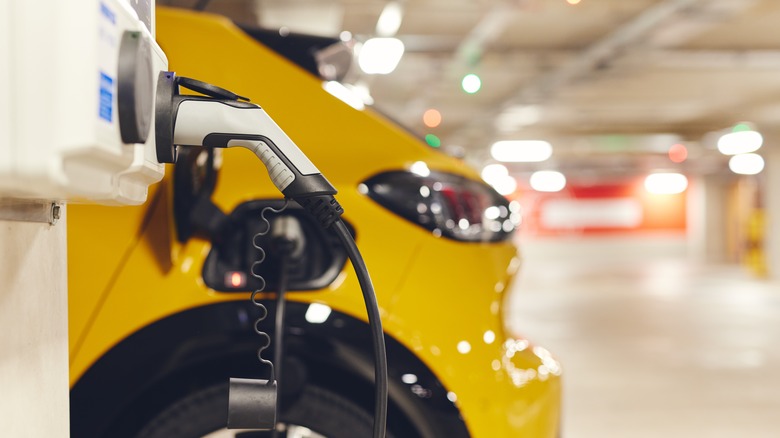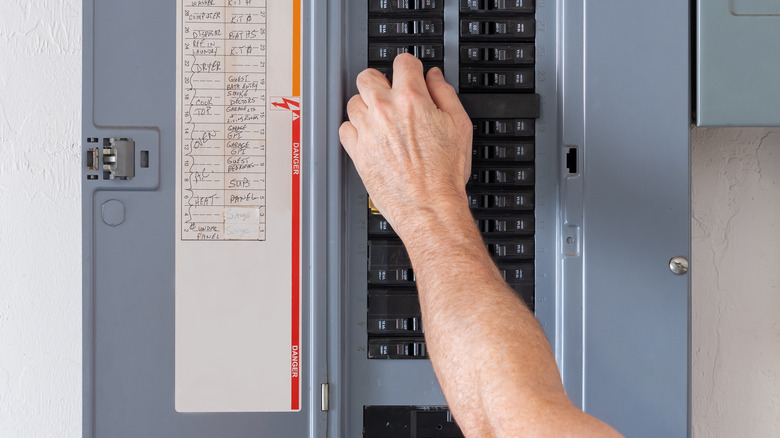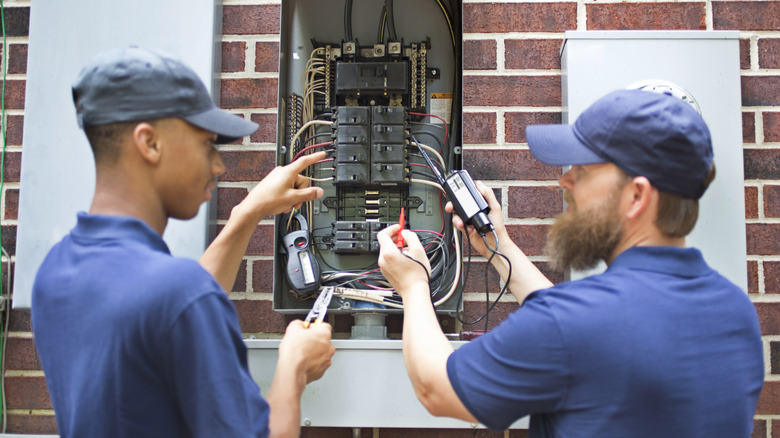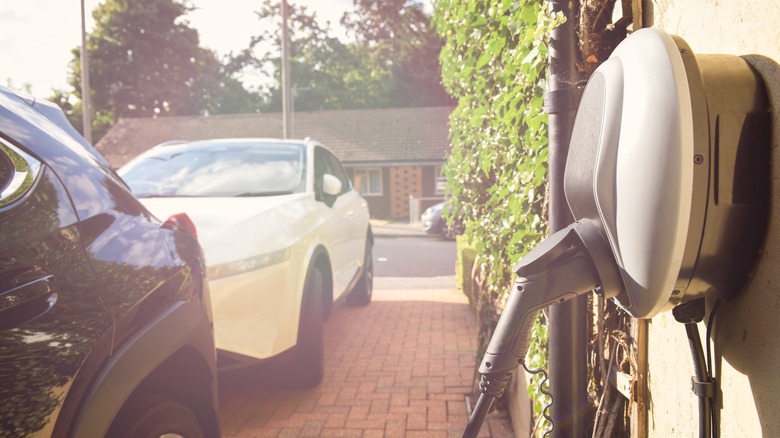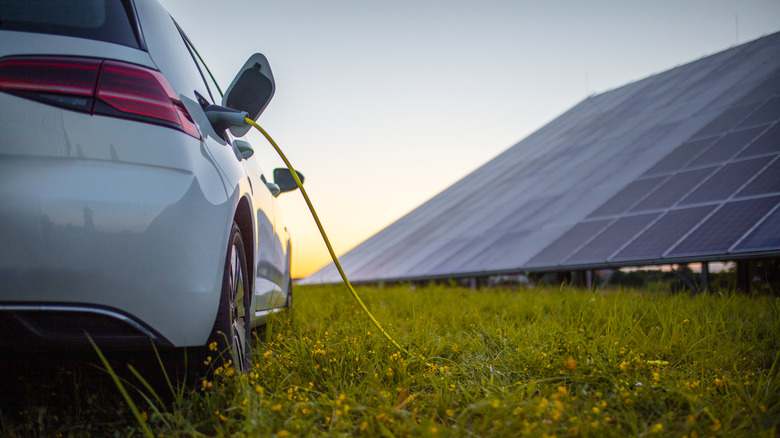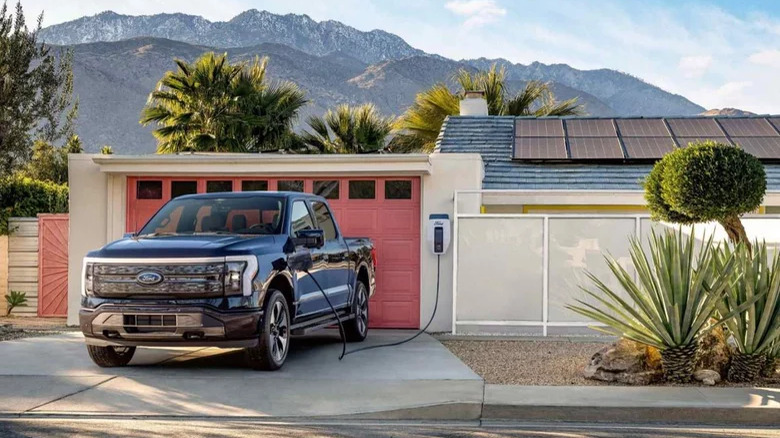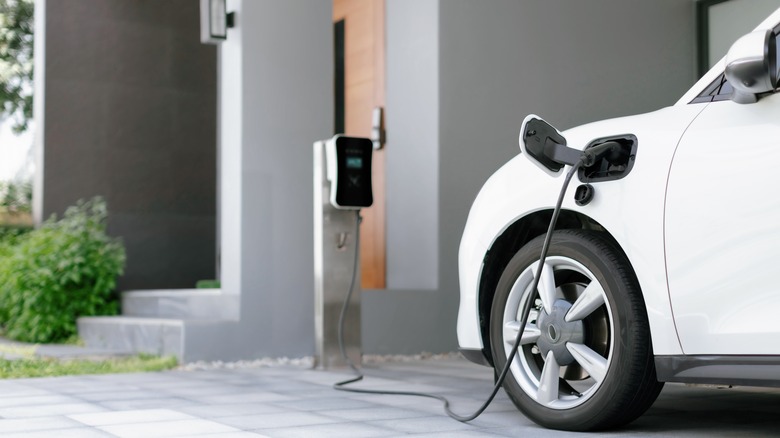10 Things Every EV Owner Needs To Know Before Installing A Home Charger
We may receive a commission on purchases made from links.
Electric vehicles may have beguiling speed and luxuriously quiet motors, but arguably the biggest advantage of ditching internal combustion is never having to stop by a gas station again. For many EV owners, an overnight charge means they start each day with a full battery. It's one of the electric perks you have to live with to truly appreciate, but it also means figuring out home charging, too.
Just about every new electric car comes with a portable charger. Increasingly, these chargers are so-called "dual mode" units, which can be used both with the regular 120V outlets commonplace in garages, and less-common — but more potent — 240V outlets, too. Nonetheless, for the fastest and most effective EV charging, most people will want to install a home charger. There are plenty of options on the market these days, ranging in price from a few hundred dollars to more than $1,000, depending on features. Figuring out which is best, though, hinges on more than just price.
Level 1 versus Level 2
When you're looking at chargers, you'll likely see Level 1, Level 2, and Level 3 referenced. They're effectively distinctions of voltage: Level 1 means a 110-120V charger compatible with the regular outlets found in North American homes. Level 2, meanwhile, refers to a 220-240V charger. (Those people who live in countries where 220-240V is the standard for domestic outlets don't need to worry about the distinction.)
A Level 1 charger can usually provide around four to five miles of range per hour that the EV is plugged in. In contrast, a Level 2 charger could add 50+ miles of range per hour connected. Level 3 is a reference to DC fast chargers commonly used at public stations; they're capable of delivering exceptionally fast recharge times, but they're not intended for domestic use as they require seriously potent electrical wiring (and come with seriously high price tags, too).
While Level 1 chargers have the benefit of plugging into easily-found outlets, most EV owners will want a Level 2 charger at home. Some need to be hardwired; others plug into a 240V outlet, typically a NEMA 14-30, 14-50, 10-30, 10-50, or 6-50. If you've got an electric dryer in your garage, you might already have a compatible outlet, though that's still no guarantee that you'll get the fastest charging speeds that your EV and your charger officially support. Different Level 2 chargers put out different amounts of power, measured in kilowatts (kW). Typically that can range from 3.6 kW to 19.2 kW, though it's worth noting that not every electric vehicle supports those higher kilowatt figures — 9.6 kW is fairly commonplace in current EVs.
For home charging, amps are king
When it comes to charging, voltage matters but so does amperage. In fact, it's probably going to be the limiting factor to how fast your EV will charge at home on a Level 2 charger. Figuring out the maximum amperage supported comes down not only to the charger hardware, but the wiring in your home. Flip open your breaker box and you'll likely see a range of circuits from 15 amps through to 100 amps. Certain appliances are more power-hungry than others — air conditioners and dryers are good examples of greedy ones — but, on a safety level, the amperage of the circuit you're plugging your EV charger into needs to support the maximum amperage that the charger itself will draw. In fact, it needs some headroom: a rating that's 25% higher, in order to comply with the U.S. National Electrical Code.
With a 20A breaker, therefore, you could use a 16A charger at most: figure on around 10 to 12 miles of range being added per hour plugged in. A 30A breaker could safely handle a 24A charger; a 50A breaker could handle a 40A charger. The current maximum that's typical for home, Level 2 chargers is 50A or 80A — potentially adding more than 50 miles of range per hour plugged in, vehicle depending — at which point you'll need a 70 to 100A circuit.
The good news, if you're waiting for a circuit upgrade, is that many Level 2 chargers support switchable amperage. That way, you can turn down the maximum charging rate to suit the outlet and wiring you have available at the time, and then turn it up later on. For new home builds, a panel supporting at least 200 amps is recommended.
Get a professional electrician to do the tricky part
If you don't already have a suitable outlet, and you're not a trained and licensed electrician, now's the time to call one in. While the wiring to a NEMA 14-50 may look straightforward, anything involving opening up the breaker panel that manages your home's electrical supply can be dangerous. For safety — both for yourself and your home — you should leave that to the experts.
The complexity (and cost) of that process will depend on exactly what your home needs. If you already have a 200 amp panel, and it's relatively near to where you want your EV charger to be positioned, it could cost $500-800 in electricians fees, though local rates will vary. If your panel needs upgrading, though, is inconveniently placed, or you have a detached garage, then you could end up spending several thousands of dollars.
While that might be a lot to stomach on top of the cost of an electric vehicle itself, there's a potential silver lining beyond just the convenience of speedy charging at home. Pre-existing support for a Level 2 EV charger could well improve the appeal of your home when it comes to selling it, with more and more homeowners likely to prioritize properties where the hard work of installation is already done. Much of the research there right now is anecdotal, admittedly, but with EV sales rising — and most automakers planning to go all-electric in the next decade — a home charger is probably only going to get more alluring.
Plug-in EV charger versus hardwired?
When it comes to power, EV chargers come in two main forms: either hardwired or plug-in. Hardwired chargers are wired into the breaker box. Plug-in chargers have a 240V plug instead.
As you might expect, there are pros and cons for each approach. A plug-in charger is arguably more flexible: if you already have a suitable outlet in your garage, you can simply plug the EV charger in yourself. If you ever move, want to upgrade charger, or use the outlet for something else (like an RV or a high-voltage tool) that's straightforward, too.
With a hardwired charger, you lose that flexibility. However, going hardwired unlocks higher amperages: an outlet is limited to 50 amps, whereas hardwiring supports up to 100 amps, unit and wiring depending. Hardwiring also removes a potential point of disconnection, or water ingress: not a bad thing to be cautious about, when you're dealing with 240 volts.
Pick the right plug
For a long time, the type of charger you wanted depended on whether you were a Tesla driver or not. Tesla's unique plug — now known as the NACS, or North American Charging Standard — was found on its own EVs, while most other automakers in North America had settled on CCS. Picking the right charger, then, was a case of deciding if you wanted Elon Musk's vehicle or something else.
Now, with NACS fast on its way to becoming an industry-wide standard — in North America at least — that situation is changing. Eventually, cars from Ford, GM, Mercedes, and others will have a NACS port, not a CCS one, though that transition is only expected to begin on new models from 2024. So, what sort of home charger should you be installing today?
If you're a Tesla owner, then a Tesla charger with the NACS plug is undoubtedly the easiest. For everybody else, a home charger with a CCS plug is still probably the way to go: after all, there are adapters available to connect a Tesla EV's NACS port with a CCS charger. When other automakers start to transition their new EVs to NACS, meanwhile, they'll be offering adapters too.
Smart vs dumb chargers
One common differentiator between electric vehicle chargers is whether they're "smart" or not. Smart chargers, so the promise goes, hook up to your home's Wi-Fi network (or, in some cases, have an embedded cellular modem, like a cellphone). That allows you to remotely monitor what rate they're charging at, adjust settings remotely from a smartphone app, and set up scheduling so that charging only takes place when electricity rates are lowest.
They're useful features — especially if your electricity provider offers an EV-specific plan, which can make it significantly cheaper if you only charge during off-peak times — but often they're already supported by the vehicle itself. It's commonplace for EVs to have a companion app, as well as to support charging schedules. In fact, having both a smart charger and using your EV's charge management systems can lead to confusion, if the two schedules clash.
There are certainly some useful elements to having a smart charger. Some power providers are able to automatically adjust charger behavior according to electricity rates, for example, while if you have a vehicle and charger that support bidirectional power — effectively using your EV as a huge battery to keep the house running in the case of a grid outage — then that can be controlled through the charger app. However, in the name of keeping it simple (not to mention cheaper), a non-connected charger that simply begins providing juice to the EV when it's plugged in might be the easiest route.
Don't discount an outdoor EV charger
Water and electricity are not, typically, the best of friends. Add in the fact that touching an outlet with wet fingers is something most of us are instructed from an early age to avoid, and you'd be forgiven for thinking charging an EV in rain or snow was a potential hazard. The good news — both for safety generally, and for figuring out where to put an electric vehicle charger specifically — is that it's not the peril you might assume it is.
In fact, EV ports and chargers are designed to be weatherproof. The ports, plugs, and cables are all waterproof, and are typically angled to encourage water to drain away rather than collect. Even if the charging cable has been sitting in a puddle, it's not transmitting power until it's plugged into the electric vehicle and the digital handshaking process — the car talking with the charger, and deciding that it's safe to begin recharging — has been completed.
If you're trying to decide where's the most convenient and flexible place to locate a Level 2 EV charger, then, you needn't necessarily be constrained to just inside a garage. Opt for fully weatherproof, outdoor-rated charger — where not only the cable and plug are waterproof, but the charger enclosure itself is watertight too, like this one by Emporia — and you could have it installed by a driveway or in a carport.
Plan ahead for solar power
Electric vehicles are arguably only truly "green" using electricity from sustainable sources. Many power companies already offer plans that rely on solar, wind, and other green energy, but there's nothing quite like recharging your EV from electricity produced at home. For most people, that means solar panels, potentially – depending on the number of panels and how much driving you typically do — keeping your EV going without ever needing to pay the electricity company. Not every home is ready for a solar upgrade, though you should still think ahead when you're picking a charger.
At their core, EV chargers aren't concerned with the source of their power. However, how they're installed, and how your home power system is configured, is key. For example, most solar systems won't supply power if the main electric grid goes down, even if the sun is shining: for that, you usually need an on-site battery, such as Tesla's Powerwall, which the solar panels charge up. Meanwhile, depending on the size of the solar array and the amount of sunlight, your panels might not generate sufficient power to recharge an EV at reasonable speeds.
For the best performance, a smart charger is often required. These can usually adjust charging rate according to what solar power is available. EV chargers that also incorporate a solar inverter are also reaching the market: these can balance solar and grid power, to ensure the maximum charging rate for a connected electric vehicle. They're significantly more expensive to buy, however, compared to regular Level 2 chargers
Even if you don't want to go that far, planning ahead when you have an electrician on-site is wise. That could mean spending the extra to have high-amperage cabling fitted — beyond just what is required for the charger you have in mind today — or even a separate breaker box in the garage.
Bidirectional charging is worth considering
Normally, we think about an electric vehicle taking power from an EV charger, and using that for propulsion. However that's not the only possibility, and when you consider an electric car is just a big battery that so happens to be on wheels, the potential for different ways to use that energy store gets far broader. One application that many people are enthusiastic about is vehicle-to-home or vehicle to grid — often known as V2H or V2G — where power can be safely returned from the EV to the home or even back to the electricity grid overall.
This bidirectional flow of power — either to the car, to charge it, or from the car, back to the home or grid — could be useful in the case of an outage. The Ford F-150 Lightning, for example, can be used instead of a portable generator if your house loses regular power, energy from the electric truck keeping your essential lights and appliances running for multiple days. General Motors and PG&E are running pilot schemes where EVs could return electricity to the power grid, during times when overall demand exceeds supply, and making EV-owners some money in the process.
It's early days for both V2H and V2G, and most mainstream Level 2 EV chargers aren't necessarily set up to do bidirectional charging. For Ford's electric truck to power your home, for instance, you'll need Ford's specific EV charger, which has to be hardwired into your home wiring. It's worth checking with the manufacturer of your electric vehicle to see if there's certain charging hardware which could unlock current or planned features later on.
Check for rebates and incentives
Electric cars aren't cheap, and neither is getting your home or garage outfitted for EV charging. A well-reviewed 50A Level 2 smart charger from Chargepoint, for example, is $630; expect to pay $200-400 for a non-Wi-Fi 32-40A charger. Then there's the outlet to plug it into and any necessary circuit and breaker upgrades that might be required, depending on your specific wiring situation.
Some automakers are bundling EV charger installation into the cost of the car. Others are offering discounted rates on hardware when you buy or lease a new model. However, it's also worth looking into other rebates and incentives that may be available to you. While the U.S. federal government has its — currently pretty confusing — tax incentive program for new EV purchases and leases, as of the Inflation Reduction Act there's also an incentive for charger installation, too. That covers 30% of the installation cost, up to $1,000.
Many U.S. states also offer rebates for those buying an electric vehicle. On a more local level, some areas have incentives to help residents offset EV charger installation, and some electricity providers also provide rebates and discounts. The U.S. Department of Energy has a database of incentives, but it's worth checking with your own power company to see what other assistance could be available.

